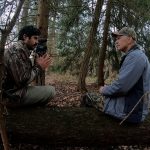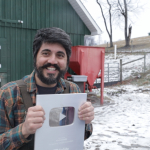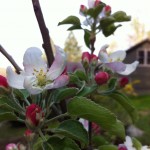Do you know what the most grown crop in the United States is? The answer many surprise you.
(you can see a awesome map of the whole USA and this crop covering it here)
 When agriculture focuses this exclusively on one crop, the land, water, and local eco-system are stressed by the constant strain of sustaining only one crop.
When agriculture focuses this exclusively on one crop, the land, water, and local eco-system are stressed by the constant strain of sustaining only one crop.
In this episode of Homesteady, we hear about how Aaron and Susan Von Frank of Tyrant Farms are tackling this problem head on. Through their Grow Journey, they’ve developed their own food forest garden that enables them to grow up to 75% of their food on their half-acre lawn. (It’s ok not to know what a Food Forest is. It’s why we have Wikipedia.)
A big part of this effort is creating this garden using heirloom seeds. Cultivating organic, heirloom seeds continues a generations-long story of agriculture and the natural development of ecosystems. Heirloom seeds have epigenetic qualities that reduce the need for pesticides and fertilizers.
Is this information on a new way of gardening enough to convince Accountant Mike to change his anti-gardening ways? Listen and see!
From the Suburban Escapee
This episode speaks to me because it reflects so much of my own homesteading journey thus far. I grew up in Lawn Country- a suburban subdivision where the summertime background soundtrack consisted of the whirring, buzzing, and tick-tick-ticking of lawn mowers, weed whackers, and sprinklers. “Gardening” consisted of multiple trays of pastel annuals, purchased at a big box store and planted in scenic rows along driveways and patios.
When the Country Boy and I moved from our urban, yard-free condo to a house with two-thirds of an acre, we had one thought: how much of this lawn can we rip up and turn into food? As we moved into our new home in late June, three years ago, with a one-year-old baby, we knew we had missed the spring planting window. Regardless, we bought a few plants at the local farmstand, stuck them in the ground, and hoped.
If memory serves me right, we got about four cherry tomatoes, six leaves of swiss chard, and enough chives to require a lawn mower. (The chives came with the house.) Literally everything else died. The soil, the Country Boy told me, was depleted from too many years of flower gardens, and too much lawn. It wasn’t going to grow anything.
Since then, we have taken multiple steps to remedy the problem. We cut down decades old shrubs and replaced them with thornless blackberry plants, raspberry brambles, and strawberries. We built a raised bed and filled it with brand-new soil. We started a compost pile. I experimented with throwing cardboard down (I mean this literally. I threw down cardboard and piled dirt on it and then planted some tomatoes). We dug a garden directly into the lawn and planted blueberry bushes (they are doing well) and planted zucchini and cucumbers (which died AGAIN this year. The soil is still terrible.) Most importantly, we have largely eschewed GMO seeds for organic, heirloom seeds.
After all this work, I am now listening to this Pioneers-only podcast about no till gardening and thinking, “MAN! I needed this three years ago!”
Not a Pioneer yet? Become one here and skip a lot of the trial and error we experienced!
This is the first year we have grown enough of anything besides green beans to actually freeze what we can’t eat right away. Our journey is still continuing as we experiment with what grows well at our house (peppers) what doesn’t (zucchini) and how we can fight pests without chemicals (squeezing japanese beetles with your bare hands is gross, but effective). But watching our two little girls literally eat bite pea pods off the vines without having to worry, “Eww, what’s on that?” makes is all worth it.





I think you missed the garden fence posts which can really add up depending on what you go with since if you want deer height you would want something tall enough. The insulators for the electric fence, the charger for it, the grounding post, and for most gardeners we need to start many of our staple summer crop seeds early either indoors under a grow light setup in a warm place or in an insulated greenhouse and will need seed trays with compost and starting mix for that too. Then there are the tools needed to tend the garden: the hoe, rake, shovel, trowel, the hose, etc. Then the water to water it when the rain isn’t there to help, and the trellis materials, tomato cages if you use them, stakes to help support plants that get tall and threaten to topple, etc. And a tape measure or other measuring device to space plantings. 🙂
But I really love the podcast! Thank you for doing it!!
Additionally, since the idea is the garden will be growing food to use, that is defraying the grocery bill for that family too rather than only replacing the costs for the lawn. 🙂
Hey S,
Actually, good news, the figure for the electric fence per linear ft was all inclusive! Posts, energizer, everything. Various tools and garden materials like tomato cages are a good addition though… nice catch. But with $1000, I think you could swing a few rakes and shovels!
Wonderful! heirloom seed is a good idea for garden. It helps gardeners reduce fertilizers and pesticides which are is not good for our environment. Great information. Thanks for the good post. Appreciated.